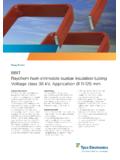Transcription of SLOPE FACE STABILIZATION FOR CRITICAL SLOPE …
1 1 SLOPE FACE STABILIZATION FOR CRITICAL SLOPE surfaces State of California Department of Transportation District 04 David W. Yam Department of Transportation 111 Grand Avenue / Box 23660 Oakland, California 94623-0660 (510) 286-5662 (510) 286-5639 Facsimile E-mail: David W. Yam, Landscape Architect, California License #1949 and CPESC #151, is the Branch Chief for the Erosion Control and Mitigation Branch in the Office of Water Quality, Caltrans District 4 in Oakland, Ca. The Erosion and Sediment Control Branch provides functional unit support for SLOPE STABILIZATION for all roadway projects in the District. Dave graduated from Berkeley in 1978 with a degree in Landscape Architecture.
2 Dave has 28 years of erosion and sediment control experience and worked with and mentored by Bob Crowell, a founding member of the International Erosion Control Association. ABSTRACT Advancements in erosion and sediment control technology have produced new and improved products, which have fostered innovative techniques for CRITICAL SLOPE face STABILIZATION . This paper reviews various SLOPE STABILIZATION techniques to address CRITICAL SLOPE surfaces related to roadway construction. Emphasis is given to showing details and describing the different products utilized in various SLOPE treatments while evaluating their effectiveness and cost. In the fall and winter of 1997-98, the El Ni o rains in Northern California yielded at least 150% of the natural rainfall of a normal winter season.
3 These conditions provided a rigorous test of the effectiveness of implemented SLOPE STABILIZATION construction techniques. In particular, this report examines Geosynthetic Stabilized Embankments (GSE) and their resulting SLOPE surfaces . GSE embankments are commonly used for over steepened slopes when a site presents limited right of way and construction constraints. GSE embankments have steep SLOPE face surfaces that present challenges in the design of functional and effective SLOPE STABILIZATION measures. Also, an effective technique for stabilizing CRITICAL excavation slopes will be reviewed and illustrated. Given these challenges, standard conventional methods of erosion control are often insufficient. By using well- established Biotechnical SLOPE Protection principles in conjunction with improved erosion control products, erosion control and SLOPE surface stability can be significantly enhanced.
4 KEYWORDS: SLOPE protection; erosion control 21. SLOPE STABILITY AND EROSION CONTROL SLOPE stability can be generally described as the inherent structural integrity of a SLOPE to resist failure. Failure can occur as slides, cracks and SLOPE movement. Erosion control is intended to provide surface SLOPE stability to protect the face of the SLOPE and to strengthen portions of the SLOPE below the surface by interlocking soil particles with a complex matrix of roots. There are differences between STABILIZATION and erosion control. The two principles have separate influence on SLOPE integrity and should be treated individually when designing embankment slopes and recommending appropriate erosion control measures. SLOPE stability, or the lack thereof, rests upon the ability of a SLOPE to resist stress excess to what is normally acceptable for the material property of the soil or rock inherent to the construction SLOPE .
5 SLOPE movements, such as translational or rotational SLOPE failures occur when sheer stress exceeds sheer strength of the materials forming the SLOPE (Gray and Leiser 1982). Factors contributing to high sheer stress include: lack of lateral support, excessive surcharges, lateral pressures and removal of underlying support. On the other hand, low sheer strength, due to inherently weak materials, soil weathering (swelling, shirking and cracking) and low intergrannular force due to seepage pressure, also contributes to SLOPE instability. Factors of safety are generally used in evaluating SLOPE stability. The factor of safety can be defined as the ratio of the total force available to resist sliding to the total force tending to induce sliding. A stable SLOPE is considered to be in a condition where the resisting forces are greater than the disturbing forces.
6 Conversely, an unstable SLOPE failure situation exists when resisting and disturbing forces are equal and the factor or safety equals F=1. A Limit Equilibrium condition exists when the forces tending to induce sliding are exactly balanced by those resisting sliding (Hoek and Bray, 1981). What is important to note is that the factor of safety can be increased by modifying resisting factors, such as tension, to counteract disturbing forces. These factors include increasing and promoting free SLOPE drainage and installing other mechanical materials to increase resistance to movement. A thorough geotechnical assessment must me done in order to determine erosion control concerns and subsequent treatments. Only after SLOPE stability factors and the probability for SLOPE failure have been addressed can appropriate surface STABILIZATION requirements be identified.
7 2. CRITICAL SLOPE surfaces A CRITICAL SLOPE surface exists when a combination of soil and SLOPE factors create a high potential for SLOPE face failure and subsequent erosion. Over-steepened freshly graded or disturbed slopes are considered CRITICAL when resistance to surface erosion is low and sheer and strength resistance tolerances are exceeded. The potential for SLOPE face failure of the SLOPE can compound with inadequate SLOPE face compaction under super saturated conditions. In such cases, soil movements are influenced by numerous parameters including, but not limited to, angle of repose, soil structure, SLOPE length and erodibility. A quick look at embankment construction techniques and constraints will provide a basis for examining factors that influence SLOPE stability.
8 Traditionally, embankment slopes constructed at gradients 1(Vertical): 2(Horizontal) and flatter can be built and compacted using common construction equipment. Generally, engineered embankment slopes are constructed in 203 millimeters (8 inch) layers. Each layer is compacted to a relative compaction of 90%. When constructing an embankment on existing hillsides, the existing hillside slopes are cut into a minimum of meters ( feet horizontal) as the embankment is brought up in layers. The cut into the existing hillside provides a way for 'keying' (bonding) the new embankment with the existing hillside. The SLOPE face of a 1:2 embankment SLOPE can be compacted by using common track laying equipment running up and down perpendicular to the SLOPE contours.
9 Water can be used to assist in promoting relative compaction. Due to the need to have a good growth medium at the SLOPE face, it is not uncommon to require the placement of 'select material', material derived from the work area that has the 3qualities of topsoil, at the outer portions of the embankment. Imported topsoil can be used in lieu of select material, but may be costly and only justifiable in cases that would warrant such use. For simplicity, this paper will address common embankment SLOPE construction gradients of 1:2, 1 and 1:1 (V:H typical) and steeper. When working in tight areas or in wildland areas with steep terrain, embankment construction can be difficult due to limited access and room. Additionally, there may be sensitive habitat contiguous to the work area that cannot be impacted.
10 In such cases, the use of geogrid reinforcement can be used to provide internal and external stability to allow construction of SLOPE gradients up to :1 and greater. When SLOPE face gradients exceed 1:2, common track laying equipment may not be appropriate for compacting the SLOPE face due to safety issues. A sheepsfoot roller connected to a winch can be used to compact the SLOPE face. However, the cost and feasibility may not make the use of a specialized piece of compaction equipment feasible. Geosynthetic Stabilized Embankments (GSE) Technological advancements in the field of embankment SLOPE construction have fostered the use of plastic geogrids to increase SLOPE stability. Generally, the use of geogrids allows the construction of embankments with steep SLOPE face gradients 1:2 and steeper.







